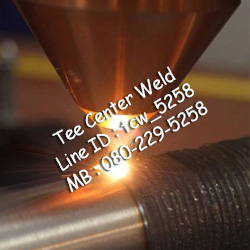ชื่อสินค้า : เลเซอร์สำหรับงานเชื่อมสเปรย์ LASER CLADDING
ยี่ห้อ : METALLIZING EQUIPMENT
รุ่น : What is Laser Cladding ?
Laser cladding falls into the group of processes commonly known as hard-facing. The laser cladding process is a method of applying a fully dense, metallurgically bonded and virtually pure coating which can be used to increase the wear resistance, corrosion resistance or impact performance of metallic components. In some cases, all three of the properties can be improved. The process utilises a precisely focussed high power laser beam to create a weld pool into which a metallic powder is applied. The powder, which is carried by a stream of inert shielding gas, is blown coaxially through the laser beam. The highly accurate nature of the laser beam allows fully dense cladding with minimal dilution (<5%), yet with a perfect metallurgical bond. Numerous coatings can be applied, the composition of which can be designed to combat the failure mechanisms associated with each component.
Fundamentals Of Laser Cladding
- Typical single layer thickness: 0.2 - 2.0mm (multiple layers possible)
- Heat input to part: low to moderate
- Dilution with substrate material: variable with parameters but can be <5% gives a very pure coating with the desired coating properties.
- Adhesion: full metallurgical bond
- Density: fully dense (<0.1% porosity)
- Coating materials: WC/Ni alloys, Ni alloys, WC/Co alloys, Stellite 6, Inconel625, FeCrB,
Benefits Of Laser Clad Coatings
One of the major benefits associated with laser cladding is the ability to finely control the heat input to the substrate and the coating material. This allows the ability to deposit a two phase Metal Matrix Composite structure. In simple terms, the coating can have a softer, lower melting point material (the matrix) in which a harder wearing, higher melting point material (the hard phase) is suspended.
The matrix material is typically a nickel based alloy. This matrix provides toughness, ductility, and impact resistance whilst being wear resistant at elevated temperatures.
A reinforcing hard phase is typically a tungsten carbide but can also be titanium nitride / carbide, chromium carbide etc.
The fine control of the heat input allows the matrix to be completely melted, alloyed and bonded to the substrate surface, whilst at the same time, the carbide particles remain un-melted and are distributed evenly throughout the matrix. This is demonstrated in the adjacent coating section. This results in an extremely wear and impact resistant coating.


